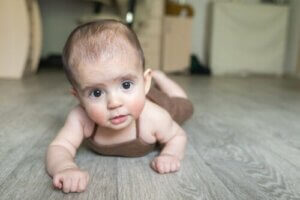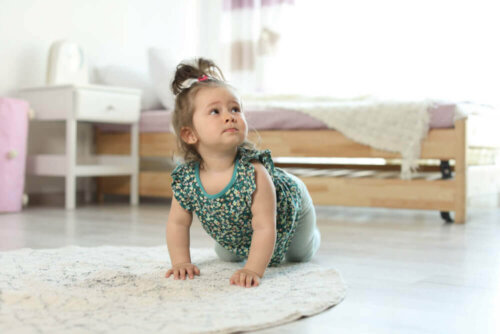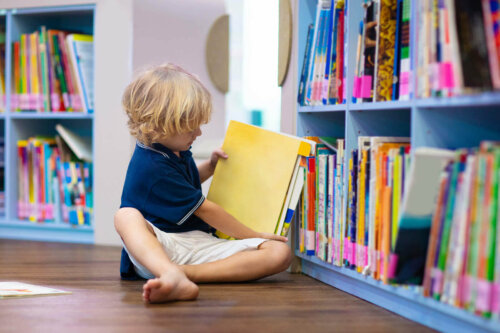The Relationship Between Crawling and Literacy

Imagine your little child climbing a ladder. If they go step by step, it’ll be easier to reach the top than if they skip a few steps, right? Something similar happens in the relationship between crawling and literacy. We’ll explain below.
Two activities that, at first, may seem so different are actually complementary. Why? Because, just like climbing a ladder, if we pass each step without skipping any, the learning process is easier.
This is symbolized by specialist professor Laura Estremera, who differentiates between children’s maturation and learning processes. If they don’t skip any steps during the development stage, we’ll succeed in minimizing the difficulties during the first few years of life, because these are very important for the future.
Learning process and the relationship between crawling and literacy
Crawling is a skill that babies learn between 9 months and one year old. It’s linked to the assimilation of reading and writing, just like other milestones a baby hits during early development.

When a baby crawls, the human brain communicates with both hemispheres and activates a crossed pattern of movement. So you can move both sides of your body simultaneously.
According to Professor Estremera, a child begins with contralateral crawling. This is where they use one arm and the opposite foot simultaneously. Thanks to this, their brains develop, which is linked to future literacy learning and other activities.
That said, while in the crawling stage, the child works on certain physical and psychological aspects that will shape their future development. For example, stability, fine and coarse motor skills, sense of touch, strength, etc.
The child develops the ability to crawl and these are linked to lateral dominance, so they use the hand with which they’re most skilled. So when you’re sitting, for example, you start learning how to pinch your fingers. This movement is closely related to using writing tools, which we grab between the thumb and index finger.
Free movement and literacy
The child, little by little, begins to move with greater ease and in turn, develop their vision and exploratory capacity. This coordination involves using their hands, eyes and whole body to get an object that interests them.
With crawling and free movement, the child becomes aware of the space around them, discovering the height, depth, distance. All this allows them to develop hand-eye coordination, which is very important when the child begins to write. They combine the information received with their ultimate goal, which is to read and write.

Therefore, crawling, like literacy, is a skill that evolves naturally, so it’s not necessary to have an adult present to accelerate the process. According to pediatrician specialist Emmi Pikler, children learn at their own pace and evolve when they’re ready.
It’s detrimental to want to accelerate young children’s natural learning processes. If they’ve climbed all the natural “steps” of their development – both during the crawling stage and later, when they learn to read and write – then they’ll have the opportunity to handle both actions in due course with ease.
Relationship between crawling and literacy, and not interfering
That said, remember: Let children set their own pace. It’s important not to interfere and accompany and guide from respect. It’ll be the infant who, little by little, is asking to learn more.
In the relationship between crawling and literacy, we find the same situation. Your child will first establish knowledge that will become vital for future learning well into adulthood and beyond.
Imagine your little child climbing a ladder. If they go step by step, it’ll be easier to reach the top than if they skip a few steps, right? Something similar happens in the relationship between crawling and literacy. We’ll explain below.
Two activities that, at first, may seem so different are actually complementary. Why? Because, just like climbing a ladder, if we pass each step without skipping any, the learning process is easier.
This is symbolized by specialist professor Laura Estremera, who differentiates between children’s maturation and learning processes. If they don’t skip any steps during the development stage, we’ll succeed in minimizing the difficulties during the first few years of life, because these are very important for the future.
Learning process and the relationship between crawling and literacy
Crawling is a skill that babies learn between 9 months and one year old. It’s linked to the assimilation of reading and writing, just like other milestones a baby hits during early development.

When a baby crawls, the human brain communicates with both hemispheres and activates a crossed pattern of movement. So you can move both sides of your body simultaneously.
According to Professor Estremera, a child begins with contralateral crawling. This is where they use one arm and the opposite foot simultaneously. Thanks to this, their brains develop, which is linked to future literacy learning and other activities.
That said, while in the crawling stage, the child works on certain physical and psychological aspects that will shape their future development. For example, stability, fine and coarse motor skills, sense of touch, strength, etc.
The child develops the ability to crawl and these are linked to lateral dominance, so they use the hand with which they’re most skilled. So when you’re sitting, for example, you start learning how to pinch your fingers. This movement is closely related to using writing tools, which we grab between the thumb and index finger.
Free movement and literacy
The child, little by little, begins to move with greater ease and in turn, develop their vision and exploratory capacity. This coordination involves using their hands, eyes and whole body to get an object that interests them.
With crawling and free movement, the child becomes aware of the space around them, discovering the height, depth, distance. All this allows them to develop hand-eye coordination, which is very important when the child begins to write. They combine the information received with their ultimate goal, which is to read and write.

Therefore, crawling, like literacy, is a skill that evolves naturally, so it’s not necessary to have an adult present to accelerate the process. According to pediatrician specialist Emmi Pikler, children learn at their own pace and evolve when they’re ready.
It’s detrimental to want to accelerate young children’s natural learning processes. If they’ve climbed all the natural “steps” of their development – both during the crawling stage and later, when they learn to read and write – then they’ll have the opportunity to handle both actions in due course with ease.
Relationship between crawling and literacy, and not interfering
That said, remember: Let children set their own pace. It’s important not to interfere and accompany and guide from respect. It’ll be the infant who, little by little, is asking to learn more.
In the relationship between crawling and literacy, we find the same situation. Your child will first establish knowledge that will become vital for future learning well into adulthood and beyond.
This text is provided for informational purposes only and does not replace consultation with a professional. If in doubt, consult your specialist.








